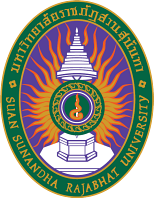Development of Lab on a Chip for Microdroplets Mixing Using EWOD Device
Keywords:
Electro-wetting on dielectric (EWOD), Droplet Manipulation, Microdroplets, Droplet MixingAbstract
Manipulating microdroplets is essential to increasing the efficiency of chip processing laboratories. It incorporated various laboratory functions while minimizing laboratory processes to the micro-scale. Therefore, in this research, a platform for mixing liquid droplets was developed at the microliter level for an electrochemistry measurement process using an Electro-wetting on dielectric (EWOD), a device that can manipulate the movement of liquid droplets on a microliter to a nanoliter scale using an electric field. The ability of the EWOD device to precisely control the liquid droplet depends on the electrode pattern, which means that proper electrode size and electrode pattern is therefore extremely important. During the research process, the researchers tested the EWOD device using voltages ranging from 300 to 700 volts and a frequency of 1,000 Hz to determine the optimal voltage for controlling the movement of 8 microliter of water droplets with the EWOD device. The research showed that the separation of liquid substances from the reservoir required at least three electrodes, and mixing liquid droplets requires at least two electrodes. From the test results of the device, it was found that the minimum voltage required by the device to start its work was 300 volts. The maximum voltage that could be applied to the device was 700 volts which caused the liquid droplet to move at an average speed 10 mm/s.
References
H. Sedgwick, F. Caron, P. B. Monaghan, W. Kolch, and J. M. Cooper, “Lab-on-a-chip technologies for proteomic analysis from isolated cells,” Journal of the Royal Society, vol. 5 no. 2, pp. 123–130, Jun. 2008.
C. D. Chin, V. Linder and S. K. Sia, “Commercialization of microfluidic point-of-care diagnostic devices,” Lab on a chip, vol. 12, no. 12, pp. 2118–2134, Jun. 2012.
O. C.-Pérez, J. C.-Terré, and M. B. Roncero, “Materials and Manufacturing Methods for EWOD Devices: Current Status and Sustainability Challenges,” Macromolecular Materials and Engineering, vol. 308, pp. 1-18, Sep. 2022.
W. Jia, P. H. Chao, S. Hanet and R. M. van Dam. “Performing multi-step chemical reactions in microliter-sized droplets by leveraging a simple passive transport mechanism,” Lab on a chip, vol. 17(24), pp. 4342–4355, Dec. 2017.
M.F. Samad, A.Z. Kouzani, M.M. Rahman, K. Magniez and A. Kaynak, “Design and Fabrication of an Electrode for Low-actuation-Voltage Electrowetting-on-Dielectric Devices,” Procedia Technology, vol. 20, pp. 20-25, July. 2015.
W. Wei, Q. Cai, S. Xu and X. Chen, “Transitional Electrodes in Electrowetting-Based Droplet Dispensing,” Biosensors, vol. 14, no. 1, pp. 1-9, Jan. 2024.
N. Sagar, S. Bansal and P. Sen, “Open-Chip Droplet Splitting in Electrowetting,” Advanced Materials Interfaces, vol. 9, pp 1-10, Sep. 2022.
H. Geng, J. Feng, L. M. Stabrylac and S. K. Cho, “Dielectrowetting manipulation for digital microfluidics: creating, transporting, splitting, and merging of droplets,” Lab on a Chip, vol. 17, pp. 1060-1068, Feb. 2017.
B. M. C. Costa, S. Griveau, F. d'Orlye, F. Bedioui, J. A. Fracassi da Silva and A. Varenne, “Microchip electrophoresis and electrochemical detection: A review on a growing synergistic implementation,” Electrochimica Acta, vol. 391, Jul. 2021.
A. T. Giannitsis, “Microfabrication of biomedical lab-on-chip devices. A review,” Estonian Journal of Engineering, vol. 17, no. 2, pp. 109–139, Apr. 2011.
W. Wang, “Precise Droplet Dispensing in Digital Microfluidics with Dumbbell-Shaped Electrodes,” Micromachines, vol. 13, no. 3, pp. 484, Mar. 2022.
K. Sukthang, E. Pengwang, W. Wechsatol and A. Tuantranont, “Rapid Fabrication of Close-Typed Electrowetting on Dielectric Devices,” IOP Conf. Series: Materials Science and Engineering, vol. 886, pp. 1-9, Jul. 2020.
E.Oliveira, C. Doering and H. Fouckhardt, “Optimizing contact angle changes for droplet actuation by optoelectrowetting (OEW): A numerical multi-parameter analysis,” Sensors and Actuators A: Physical, vol. 365, Nov 2023.
S.N.I.S. Zulkepli, N.H. Hamid; V. Shukla, “Droplet Velocity Measurement Based on Dielectric Layer Thickness Variation Using Digital Microfluidic Devices,” Biosensors, vol. 8, no. 45, pp. 1-12, May. 2018.
Downloads
Published
How to Cite
Issue
Section
License
Copyright (c) 2024 Faculty of Industrial Technology, Suan Sunandha Rajabhat University

This work is licensed under a Creative Commons Attribution-NonCommercial-NoDerivatives 4.0 International License.
บทความที่ได้รับการตีพิมพ์เป็นลิขสิทธิ์ของคณะเทคโนโลยีอุตสาหกรรม มหาวิทยาลัยราชภัฎสวนสุนันทา
ข้อความที่ปรากฏในบทความแต่ละเรื่องในวารสารวิชาการเล่มนี้เป็นความคิดเห็นส่วนตัวของผู้เขียนแต่ละท่านไม่เกี่ยวข้องกับมหาวิทยาลัยราชภัฎสวนสุนันทา และคณาจารย์ท่านอื่นๆในมหาวิทยาลัยฯ แต่อย่างใด ความรับผิดชอบองค์ประกอบทั้งหมดของบทความแต่ละเรื่องเป็นของผู้เขียนแต่ละท่าน หากมีความผิดพลาดใดๆ ผู้เขียนแต่ละท่านจะรับผิดชอบบทความของตนเองแต่ผู้เดียว







